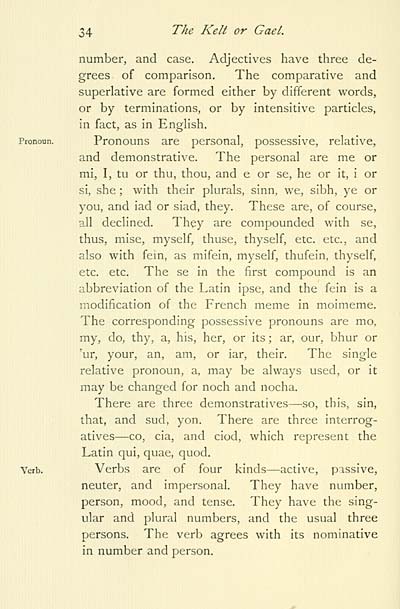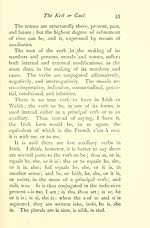Blair Collection > Kelt or Gael
(38)
Download files
Complete book:
Individual page:
Thumbnail gallery: Grid view | List view

34 ^/^^ K^ii or Gael.
number, and case. Adjectives have three de-
grees of comparison. The comparative and
superlative are formed either by different words,
or by terminations, or by intensitive particles,
in fact, as in English.
Pronoun. Pronouns are personal, possessive, relative,
and demonstrative. The personal are me or
mi, I, tu or thu, thou, and e or se, he or it, i or
si, she ; with their plurals, sinn, we, sibh, ye or
you, and lad or siad, they. These are, of course,
all declined. They are compounded with se,
thus, mise, myself, thuse, thyself, etc. etc., and
also with fein, as mifein, myself, thufein, thyself,
etc. etc. The se in the first compound is an
abbreviation of the Latin ipse, and the fein Is a
modification of the French meme in moimeme.
The corresponding possessive pronouns are mo,
my, do, thy, a, his, her, or its ; ar, our, bhur or
'ur, your, an, am, or iar, their. The single
relative pronoun, a, may be always used, or it
may be changed for noch and nocha.
There are three demonstratives — so, this, sin,
that, and sud, yon. There are three interrog-
atlves — CO, cia, and clod, which represent the
Latin qui, quae, quod.
Verb. Verbs are of four kinds — active, passive,
neuter, and Impersonal. They have number,
person, mood, and tense. They have the sing-
ular and plural numbers, and the usual three
persons. The verb agrees with its nominative
in number and person.
number, and case. Adjectives have three de-
grees of comparison. The comparative and
superlative are formed either by different words,
or by terminations, or by intensitive particles,
in fact, as in English.
Pronoun. Pronouns are personal, possessive, relative,
and demonstrative. The personal are me or
mi, I, tu or thu, thou, and e or se, he or it, i or
si, she ; with their plurals, sinn, we, sibh, ye or
you, and lad or siad, they. These are, of course,
all declined. They are compounded with se,
thus, mise, myself, thuse, thyself, etc. etc., and
also with fein, as mifein, myself, thufein, thyself,
etc. etc. The se in the first compound is an
abbreviation of the Latin ipse, and the fein Is a
modification of the French meme in moimeme.
The corresponding possessive pronouns are mo,
my, do, thy, a, his, her, or its ; ar, our, bhur or
'ur, your, an, am, or iar, their. The single
relative pronoun, a, may be always used, or it
may be changed for noch and nocha.
There are three demonstratives — so, this, sin,
that, and sud, yon. There are three interrog-
atlves — CO, cia, and clod, which represent the
Latin qui, quae, quod.
Verb. Verbs are of four kinds — active, passive,
neuter, and Impersonal. They have number,
person, mood, and tense. They have the sing-
ular and plural numbers, and the usual three
persons. The verb agrees with its nominative
in number and person.
Set display mode to: Large image | Transcription
Images and transcriptions on this page, including medium image downloads, may be used under the Creative Commons Attribution 4.0 International Licence unless otherwise stated. ![]()
| Early Gaelic Book Collections > Blair Collection > Kelt or Gael > (38) |
|---|
| Permanent URL | https://digital.nls.uk/75787102 |
|---|
| Description | His ethnography, geography and philology. |
|---|---|
| Shelfmark | Blair.17 |
| Additional NLS resources: | |
| Attribution and copyright: |
|
| Description | A selection of books from a collection of more than 500 titles, mostly on religious and literary topics. Also includes some material dealing with other Celtic languages and societies. Collection created towards the end of the 19th century by Lady Evelyn Stewart Murray. |
|---|
| Description | Selected items from five 'Special and Named Printed Collections'. Includes books in Gaelic and other Celtic languages, works about the Gaels, their languages, literature, culture and history. |
|---|

